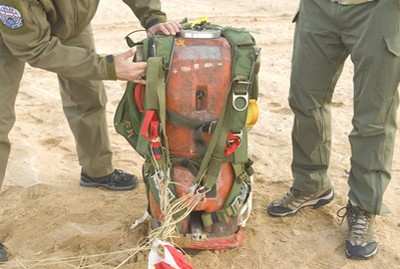"Guardian Angel" Designed For Safety At Higher Altitudes
Officials at Edwards AFB in California are creating a guardian
angel system to help Air Force members who parachute to land safely
and softly. The plan is to replace the Air Force's nearly
five-decades-old parachute system with a new one, called the
Guardian Angel Advance Parachute System, which is designed for
safer landings at higher altitudes

Guardian Angel Parachute System
The Air Force's official parachute test organization, which
falls under the 418th Flight Test Squadron, are creating this new
system.
GAAPS is a threefold system, which includes a freefall parachute
system, a static-line parachute and a tandem parachute system. The
parachute's canopy is made with a special type of fabric designed
to allow the user to land at high altitudes. "With the current
systems, the descent rate is too fast at high altitudes," said 2nd
Lt. Jonathan Sepp, a 418th airdrop engineer. "That's because our
current systems were designed in the 1960s for landing at sea
level, and that worked (well) for them then, but now we're in
Afghanistan, so we have to develop something for the modern
warfighter who has to land in austere mountain conditions."
GAAPS is designed to fit a variety of missions for rescue
professionals. To accommodate a variety of mission needs, each of
the parachute systems fits different situations. A single
pararescueman jumping into adverse terrain with a load of gear
would typically use the single free fall system. In other cases, a
pararescueman with a load of gear may need to be inserted low and
fast, and will not need to steer the parachute. In that case he
would use the static-line system. If a pararescueman needed to
bring a medic with him, he could put the medic on a second harness
connected to him, jumping with the tandem system.
With the team going into its third year of testing, safety is
paramount and ensuring that a parachute system is safe requires a
lot of scrupulous testing, Lieutenant Sepp said. "We started
testing in 2009. There have been a few road blocks that we ran into
because experimental parachutes have a lot of things that have to
be worked out before you give it the 100-percent thumbs up,"
Lieutenant Sepp said. "We make sure the testing is really thorough
and that we've worked out every kink before we even think about
approving a system."
The tests begin with functional testing on the ground to ensure
that when the user tries to operate it, it will work the way it was
intended. "We started with different ground tests, like seeing how
hard it is to pull certain handles and tensile tests on the ground
to make sure certain things aren't going to break in the air when
you strap a lot of weight to it," the lieutenant said. "Currently,
we're performing dummy tests where we strap the parachute to a
dummy that simulates a human being, and push it out of an airplane
to see how the system actually works in air. Then you have a lot of
review boards, and that leads to live-jump testing where you
actually put it on the test parachutists. After the test
parachutists jump with it they review it and tell us how things
worked."

While GAAPS is being created primarily for use by Air Force
pararescuemen, Lieutenant Sepp said he believes that once this
system is implemented it will be the primary system used by every
military branch.
"The parachutes are designed for pararescuemen who are going to
be landing in austere mountain conditions to rescue personnel,"
Lieutenant Sepp said. "But GAAPS is also going to take over for a
lot of the current parachute systems and potentially be applied
across the Air Force and the rest of the military once it's
approved.
"The systems the Air Force has now are getting older, out of
date and worn out so we need to replace them with new parachute
systems and GAAPS is going to do that for us," he said. "It's going
to allow people to land in a safer manner, carry more gear and
accomplish the mission more effectively than they could've with the
parachute systems we currently have."
The GAAPS testing is scheduled to wrap up around the end of
February 2011.
 ANN's Daily Aero-Term (04.20.24): Light Gun
ANN's Daily Aero-Term (04.20.24): Light Gun Aero-News: Quote of the Day (04.20.24)
Aero-News: Quote of the Day (04.20.24) ANN's Daily Aero-Linx (04.21.24)
ANN's Daily Aero-Linx (04.21.24) Aero-News: Quote of the Day (04.21.24)
Aero-News: Quote of the Day (04.21.24) ANN's Daily Aero-Term (04.21.24): Aircraft Conflict
ANN's Daily Aero-Term (04.21.24): Aircraft Conflict




